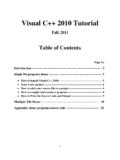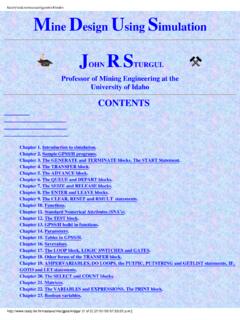Transcription of William Paterson University of New Jersey - cs-cit.wpunj.edu
1 William Paterson University of New Jersey Department of Computer Science College of Science and Health Course Outline 1. TITLE OF COURSE AND COURSE NUMBER: Computer simulation , CS404, (Major elective course) 2. DESCRIPTION OF THE COURSE: Theory, programming methodology, algorithm design, and practical applications of computer simulation . Topics include: modeling of deterministic systems, stochastic systems, generation of random variables and distributions, queuing models, collection and analysis of statistics from runs. Applications in computer system and network design and performance. Assigned projects concentrate on programming simulation models using C/C++ and simulation languages such as GPSS or SIMSCRIPT. 3. COURSE PREREQUISITES: CS 342 with a grade of C- or better 4. COURSE OBJECTIVES: To understand the principles of systems simulation .
2 To develop mathematical tools for system modelling. To teach the programming methodology required to design and validate simulation programs. To familiarize student with the structure and behavior of complex systems. 5. STUDENT LEARNING OUTCOMES: Upon completion of this course, students are expected to: a) Think in terms of systems, their characterization with sufficient state variables, their classification into several categories (such as deterministic but not analytically solvable), and conduct inquiry on their modeling, formulation, and varying approaches towards problem-solving in these systems. Measure: exams, surveys, and projects. b) Demonstrate a thorough understanding of their knowledge of probability and statistics, with a strong emphasis on applications in Computer Science and the programming of simulation models. The theory of distributions and, in particular, several important distributions will be studied so student will be capable of recognizing under what conditions and situations to apply which distribution, both in synthesis of simulation models and analysis of data generated.
3 They should be familiar with several algorithms to generate specific and empirical distributions. Measure: exams, surveys, and projects. c) Develop an appreciation of the nature of randomness and its many relations to algorithmic complexity (from the abstract levels of Chaitin's work to the concrete developments of probabilistic algorithms). They should know what are pseudo-random numbers, their history (the key papers/research on their generators), and how to interpret them and the significance of results based on them in a scientific/decision-oriented manner. Measure: exams, surveys, and projects. d) Be capable of programming moderately complex systems simulations, both discrete event and continuous. Measure: exams and projects. e) Develop proficiency in at least one special-purpose simulation programming language (GPSS or Arena) and also in designing simulation programs with standard C++.
4 Measure: exams and projects. 6. TOPICAL OUTLINE OF THE COURSE CONTENT: 1) Fundamentals a. Definition and reasons for simulation . b. Continuous (time-oriented) and discrete (event) systems c. Modeling/programming simple deterministic systems d. Rates and system dynamics 2) Concepts in simulation : Stochastic variables; discrete vs continuous probability; algorithms for generating random numbers, their comparison with respect to speed and validity; continuous uniformly distributed random numbers; methods for generating non-uniform distributions. 3) Building simulation programming models: Arrival patterns, service times, and queue formation. Formulating systems as events and entities (such as resources, queues, gates, and linkages). Congestion in systems; arrival patterns; Poisson arrivals; the exponential distribution; the coefficient of variation; service times; normal distribution; queuing disciplines; Measures for Queues; Analytic Solutions of Queuing Problems; Utilization as a Design Factor; Other factors like grade of service.
5 4) Discrete event system simulation : Discrete events; representation of time; queues and servers; generation of arrival patterns; resource seizing; departures simulation of a telephone system and computer networks; simulating components of an operating system; delayed calls; modeling policies; priority queues; tasks; gathering statistics; counters and summary statistics; measuring utilization and occupancy; recording distributions and transit times. 5) Introduction to a simulation Languages (such as SIMSCRIPT, GPSS, or Arena): SIMSCRIPT programs; SIMSCRIPT system concepts; organization of a SIMSCRIPT program; blocks, names, and labels; SIMSCRIPT statements; entities, events, and activities; defining the system; defining the system model; referencing variables; the procedural structures; arrival event; timing routine; disconnect event; closing event; execution, debugging and validation; interpreting outputs and system optimization via modification.
6 6) Recent directions and topics 7. GUIDELINES/SUGGESTIONS FOR TEACHING METHODS AND STUDENT LEARNING ACTIVITIES: A. Classroom lectures, discussions, and problem-solving sessions B. Homework reviews and pre-exam reviews 8. GUIDELINES/SUGGESTIONS FOR METHODS OF STUDENT ASSESSMENT (OUTCOMES): a) Periodic examinations and cumulative final examination b) Several programming projects c) Term paper on modern simulation article in the recent literature 9. SUGGESTED READINGS, TEXTS, OBJECTS OF STUDY: " simulation Modelling and Analysis", (Third Edition), Law and Kelton, McGraw-Hill, 2000. Handouts based on Barrondale, Snell and other sources. 10. BIBLIOGRAPHY OF SUPPORTIVE TEXTS AND OTHER MATERIALS: "Discrete-Event System simulation , (Fourth Edition), Banks, Carson, Nelson, and Nicol, Prentice-Hall, 2004. Handbook of simulation : Principles, Methodology, Advances, Applications, and Practice , Jerry Banks (Editor), Wiley, 1998.
7 "Elementary Computer Applications in Science, Engineering, and Business", Barrondale, Roberts, & Ehle, John Wiley and Sons, New York, NY, 1971. simulation Modeling Handbook: A Practical Approach , Chris Chung,, CRC Press, 2003. Applied Modeling and simulation , David Cloud, McGraw-Hill, 1998. simulation Modeling with SIMUL8 , Kieran Concannon, Mark Elder, Kim Hunter, Jillian Tremble, and Stanley Tse, Visual Thinking International Ltd., 2003. "Getting Started in GPSS", Dunning, Engineering Press, San Jose, CA, 1985. "Concepts and Methods in Discrete Event Digital simulation ", Fishman, John Wiley and Sons, New York, 1973. "Principles of Discrete Event simulation ", Fishman, John Wiley and Sons, New York, 1978. " simulation Model Design and Execution", Fishwick, Prentice-Hall, 1995. "System simulation ", Gordon, G., Prentice-Hall, Englewood Cliffs, NJ, 1978.
8 "The Application of GPSSV to Discrete Systems simulation ", Geoffrey Gordon, Prentice-Hall 1975. " simulation : Principles and Methods", Graybeal and Pooch, Winthrop 1980 "GPSS Primer", Stanley Greenberg, John Wiley, 1972. simulation using Promodel , 2nd Edition (w/ CD-Rom), Charles R. Harrell, Biman K. Ghosh, and Royce O. Bowden, McGraw-Hill, 2004, simulation Modeling Methods: To Reduce Risks and Increase Performance (w/CD-Rom), H. James Harrington, McGraw-Hill; 2000. Learning SIMUL8: The Complete Guide , Jaret W. Hauge and Kerrie N. Paige, Plain Vu Pub., The Pleasures of Probability , Richard Isaac, Springer Verlag, 1996. "Modern Statistical Systems and GPSS simulation ", Karian and Dudewicz, Computer Science Press, 1991. simulation with Arena , Third Edition (w/ CD-Rom), W. David Kelton, Randall P Sadowski, and David T Sturrock, McGraw-Hill, 2004.
9 " simulation of Discrete Stochastic Systems", Maisel and Gnugoli, 1972. "Computer simulation ", McHaney, Academic Press, 1991. "Introduction to simulation , Programming Techniques and Methods of Analysis", Payne, McGraw-Hill, 1982. simulation With Visual Slam and Awesim , Alan B. Pritsker, Wiley, 1997. Introduction to simulation and SLAM II , (Fourth Edition),. Alan B. Pritsker, Wiley, 1995. "Computer simulation Models", John Smith, Hafner 1968. "An Introduction to simulation using GPSS/H", Schrieber, Wiley, 1991. " simulation using GPSS", Schrieber, Wiley, 1974. simulation : A Modeler's Approach , James R. Thompson, Wiley, 1999. "Computer simulation ", Watson and Blackstone, Wiley, 1989. Theory of Modeling and simulation , Bernard P. Zeigler, Tag Gon Kim, and Herbert Praehofer, Academic Press, 2000. 11. PREPARER'S NAME AND DATE: Dr.
10 John Najarian 12. ORIGINAL DEPARTMENTAL APPROVAL DATE: Spring, 1996 13. REVISERS' NAME AND DATE: Dr. John Najarian Spring 2005, previously 4/1/2000 14. DEPARTMENTAL REVISION APPROVAL DATE: Spring 2005










